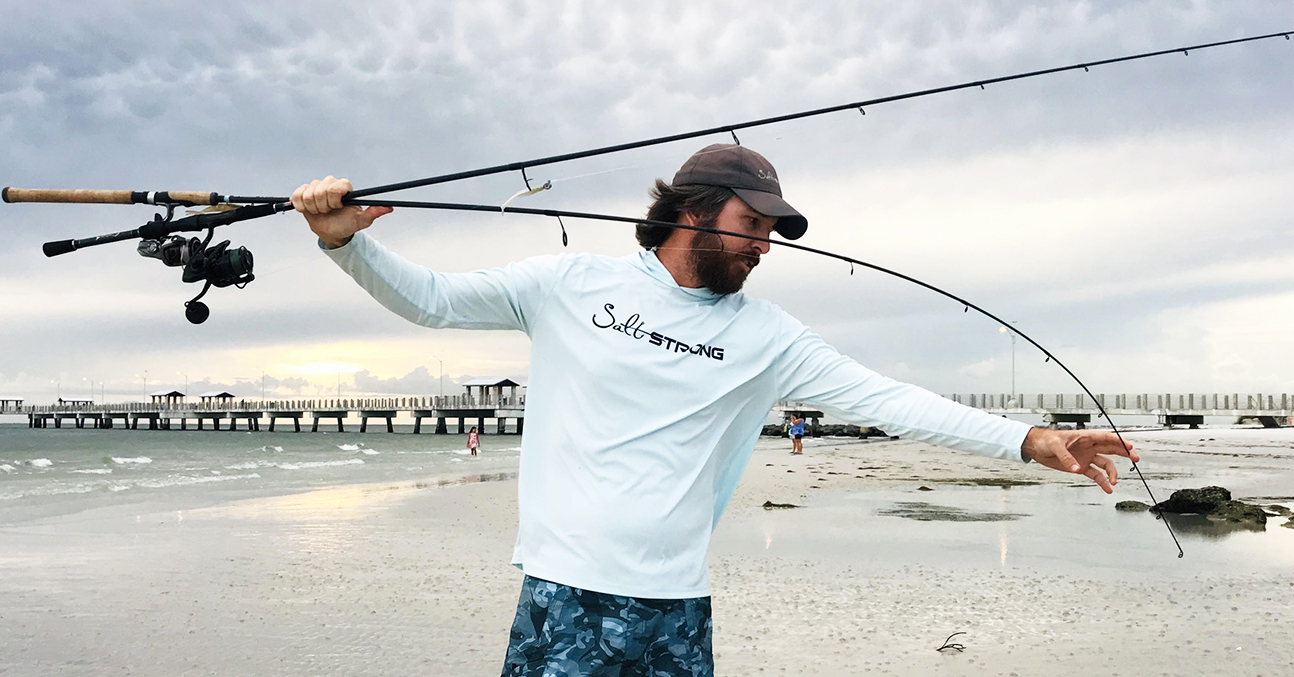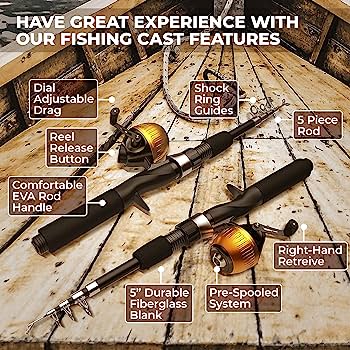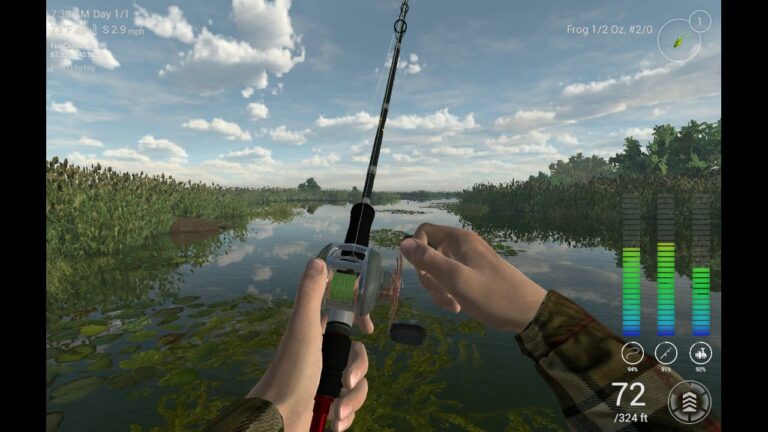The best pound test line for bass fishing is typically between 10 and 15 pounds. Bass fishing requires a line that is strong enough to handle the potential size and strength of the fish, yet not too heavy that it affects the presentation of lures and baits.
A 10-15 pound test line strikes a good balance, providing enough strength to handle larger bass, while still allowing for sensitive and accurate lure action. Additionally, this pound test range is versatile, suitable for various fishing techniques and conditions. It is important to consider factors such as the size of the bass in the area you are fishing, the type of cover you are fishing in, and the fishing techniques you plan to use when selecting the best pound test line for bass fishing.
Overall, a 10-15 pound test line is a reliable choice for most bass fishing scenarios.

Credit: www.saltstrong.com
Understanding The Importance Of Choosing The Right Pound Test Line
When it comes to bass fishing, choosing the right pound test line is crucial. The pound test rating of a fishing line refers to the amount of weight it can handle before breaking. Understanding the impact of the pound test rating on the performance of the line is essential for any angler.
Here, we will explore the factors to consider when selecting a pound test line for bass fishing, as well as the importance of line strength for different fishing techniques.
Factors To Consider When Selecting A Pound Test Line For Bass Fishing:
- Fishing conditions: The first thing to consider is the fishing conditions you’ll be facing. Is it a clear, open water or heavy cover fishing? The type of cover and structure in your fishing area will determine the pound test line you need. For heavy cover fishing, where the risk of your line snagging is high, a heavier pound test line is recommended. On the other hand, for clear water fishing, where the bass may be wary, you’ll want to use a lighter line to prevent spooking the fish.
- Size of fish: Another important factor to consider is the size of the bass you’re targeting. Larger bass have more power and can easily break a lighter line. As a general rule, use a pound test line that is equal to or slightly higher than the weight of the fish you expect to catch. This will ensure that your line is strong enough to handle the fight without snapping.
- Fishing techniques: Different fishing techniques require different pound test lines. For example, if you’re using topwater lures or finesse techniques, a lighter line in the 8-12-pound range is suitable. For flipping and pitching, where you’re casting heavy lures into heavy cover, a high-pound test line in the 14-20-pound range is advisable.
How The Pound Test Rating Affects The Performance Of The Line:
- Casting distance: The pound test rating of your line can have a significant impact on casting distance. Lighter lines have less resistance in the air and can be cast farther, allowing you to cover more water. However, it’s important to find a balance between distance and line strength. Using a line that’s too light may compromise your ability to handle and control the fish once it’s hooked.
- Sensitivity: The pound test rating also affects the sensitivity of your line. Lighter lines are more sensitive and can transmit subtle bites and movements more effectively. This is particularly important when using finesse techniques that require detecting the slightest nibble. On the other hand, heavier lines sacrifice some sensitivity but provide added strength and durability.
The Impact Of Line Strength On Different Bass Fishing Techniques:
- Finesse techniques: Finesse techniques like drop shotting and shaky head fishing require finesse in presentation. Using a light line (6-10-pound test) allows for better lure action and a more natural presentation. It also increases the chances of getting more bites from wary bass.
- Flipping and pitching: For heavy cover fishing techniques like flipping and pitching, where you’re targeting bass hiding in dense vegetation or under docks, a high-pound test line (14-20 pound test) is necessary. This heavier line helps in pulling the bass out from the cover and provides the required strength to handle aggressive strikes.
- Topwater fishing: When using topwater lures like buzzbaits or poppers, a lighter line in the 8-12-pound test range is preferred. The reduced line visibility and increased sensitivity of a lighter line amplify the excitement of topwater strikes.
Choosing the right pound test line for bass fishing is vital for success on the water. By considering the fishing conditions, the size of the fish, and the specific fishing techniques you’ll be using, you can make an informed decision.
Remember, it’s all about finding a balance between line strength, casting distance, and sensitivity to maximize your chances of landing that trophy bass.
Comparing Pound Test Options For Bass Fishing
Bass fishing requires careful consideration of the pound test line to ensure success on the water. The pound test refers to the line’s strength and its ability to withstand the force of a hooked bass. There are various options available, each with its own advantages and disadvantages.
Let’s explore the pros and cons of different pound test lines.
Exploring The Pros And Cons Of Different Pound Test Lines:
- Lighter pound test lines (4-8 lb):
- Offers increased sensitivity, allowing anglers to detect even the slightest nibbles and bites.
- Provides excellent maneuverability for precise lure presentations.
- Ideal for finesse fishing techniques such as drop shotting and wacky rigging.
- However, may lack the strength needed to handle larger bass or heavier cover, increasing the risk of line breakage.
- Medium pound test lines (10-15 lb):
- Strikes a balance between strength and sensitivity.
- Offers versatility to handle a wide range of fishing techniques and cover types.
- Provides adequate strength to withstand the fight of an average-sized bass.
- Suitable for fishing in moderate to heavy cover.
- However, may sacrifice some sensitivity compared to lighter pound test lines.
- Heavier pound test lines (17+ lb):
- Provides exceptional strength to handle big bass and heavy cover situations.
- Offers increased confidence when battling with larger and more aggressive bass.
- Suitable for fishing in dense vegetation, thick brush, or around heavy structure.
- However, sacrifices some sensitivity and may reduce lure action due to increased line thickness.
Analyzing the performance of different pound test lines allows anglers to tailor their approach based on fishing conditions and their personal preferences. Consider the pros and cons of each pound test option to find the best fit for your bass fishing endeavors.
Remember, choosing the right pound test line is crucial for landing the big ones while ensuring a memorable and successful fishing experience.
Matching Pound Test Line With Fishing Conditions And Techniques
As an avid bass angler, one of the key decisions you’ll face when gearing up for a successful fishing trip is choosing the right pound test line. The pound test refers to the amount of weight that a fishing line can withstand before breaking.
Matching the pound test line with the fishing conditions and techniques you’ll be using is essential for landing those big bass. Let’s take a look at how you can adapt the pound test line to different fishing environments and techniques, and explore real-life examples of successful pound test line selection in bass fishing tournaments.
Adapting The Pound Test Line To Various Fishing Environments (Clear Water, Heavy Cover):
When fishing in clear water or areas with minimal obstacles, using a lighter pound test line can provide several advantages. The key points to consider are:
- Lighter lines are less visible underwater, reducing the chances of spooking the bass.
- They allow for longer and more accurate casts, increasing your chances of reaching distant targets.
- Lighter lines have less resistance in the water, resulting in a more natural presentation of your bait.
- However, lighter pound test lines may not be suitable for heavy cover fishing, where the chances of line breakage are higher.
On the other hand, when fishing in heavy cover where there are plenty of potential snagging opportunities, using a heavier pound test line becomes crucial. Consider the following points:
- Heavier lines provide increased strength and abrasion resistance, allowing you to haul bass out of thick cover without worrying about breaking your line.
- They can withstand the punishment of dragging your bait through vegetation without sacrificing your chances of a successful hookset.
- However, heavier lines may be more visible to bass in clear water conditions and could potentially affect your catch rate.
Determining The Ideal Pound Test Line For Specific Bass Fishing Techniques (Topwater, Finesse, Deep Diving):
The ideal pound test line for specific bass fishing techniques can vary greatly. Here are a few important considerations for different techniques:
- Topwater fishing: When using topwater lures such as frogs, buzzbaits, or poppers, a lighter pound test line ranging from 8 to 12 pounds is commonly used. The lighter line helps to maximize the action of the lures and increase the chances of bass striking.
- Finesse fishing: Finesse techniques such as drop shotting or using small soft plastic baits require a more subtle approach. A lighter pound test line ranging from 4 to 8 pounds is often preferred, as it allows for better bait presentation and increased sensitivity to detect those delicate bites.
- Deep diving: When fishing deep structures using crankbaits or diving plugs, a heavier pound test line ranging from 10 to 20 pounds is recommended. The heavier line helps in achieving maximum diving depths, resisting the pressure of the water, and minimizing the chances of line breakage.
Case Studies: Real-Life Examples Of Successful Pound Test Line Selection In Bass Fishing Tournaments:
Real-life examples can provide valuable insights into the impact of pound test line selection in bass fishing tournaments. Consider these instances:
- In a recent tournament, the winning angler opted for a lighter 10-pound test line when fishing in clear water. This allowed them to make accurate long-distance casts to secluded bass-holding spots, resulting in a higher catch rate compared to anglers using heavier lines.
- On the other hand, in a tournament held in heavy cover, the second-place angler made a strategic choice to go for a heavier 20-pound test line to tackle the thick vegetation. This decision paid off, as they successfully pulled out several trophy-sized bass from the dense cover.
- Another example is the use of a 6-pound test line by a finesse fishing specialist. This lighter line enabled them to present small finesse baits with finesse and finesse, consistently outperforming competitors who opted for heavier lines and missed out on subtle bites.
Adapting the pound test line to different fishing conditions and techniques can significantly impact your bass fishing success. Understanding the advantages and disadvantages of using lighter or heavier lines in clear water, heavy cover, topwater, finesse, and deep diving scenarios can help you make informed decisions.
It’s always worth considering real-life examples of successful pound test line selection in bass fishing tournaments to fine-tune your approach and increase your chances of landing that trophy bass. So, next time you hit the water, don’t underestimate the importance of matching your pound test line with the fishing conditions and techniques at hand.
Happy fishing!
Conclusion
Choosing the right pound test line for bass fishing is crucial for a successful angling experience. It demands an understanding of various factors such as the bass species, water conditions, and your fishing technique. For beginners, starting with a 10-12 pound test line is a safe choice.
It offers a balance between strength and sensitivity, enabling you to handle most bass with ease. Intermediate and advanced anglers may opt for a higher pound test line, such as 14-20 pounds, to tackle larger and more aggressive bass. Remember, using a light line can enhance your chances of getting more bites, while a heavier line provides the needed power to control bigger fish.
Ultimately, experimentation and experience will guide you toward the best pound test line for your unique fishing needs. So, do your research, consider the factors mentioned, and go catch those bass!






